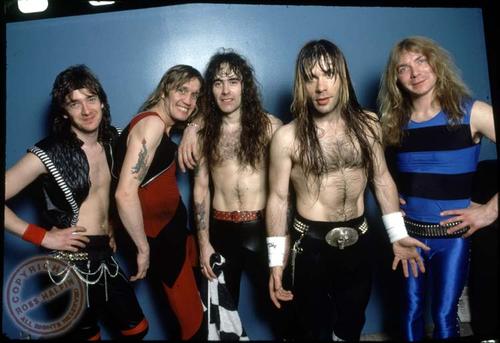
Iron Maiden’s first live record has gone down in history as one of the greatest live albums of all time, and for good reasons. Live After Death documents a metal legend at the height of its power.
Live After Death
Produced by Martin “Live Animal” Birch
Released 14 October 1985
Live After Death was a long-awaited live album in its time. Maiden could possibly have released the Hammersmith show in 1982 as a live record (it sounds bloody awesome, and would have been an obvious live record these days), but they decided to not even release it as a VHS video, which had been the original plan.
Nothing was filmed or recorded on tour in 1983, apart from the significantly shortened final show at the Dortmund festival in December, so if the band didn’t document their groundbreaking 1984-85 Powerslave tour we’d be facing a case of unforgivable neglect of the band’s early days and classic era, clearly akin to cultural sabotage.
Click here for our review of Powerslave (1984)!
But it finally happened. Recorded at California’s Long Beach Arena (with the Record Plant Mobile) and London’s Hammersmith Odeon (with the Rolling Stones Mobile) during the World Slavery Tour in ’84 and ’85, the Live After Death show centers on the best material from the then current Powerslave album, interspersed with other selected catalog highlights.
It is all culled from the band’s incredible opening salvo of 5 albums in 4 years. There’s not a single song here that could easily have been dropped, and there is still a pile of masterworks that didn’t make the set.
Add to all of that another artwork masterpiece by Derek Riggs, in which the previously entombed Eddie rises to live again:
Live After Death has always been a double album, and so there was always a gatefold sleeve like the 180g vinyl reissue. Maiden’s 1980s period was a visual feast as well as a musical adventure, so picture discs inevitably also had to be issued. Those discs themselves carry other Riggs illustrations for the World Slavery Tour and Live After Death, as well as the Phantom Of The Opera-themed painting that was issued with the live Run To The Hills single:

Yes, there are some serious vibes with Live After Death! Whatever one thinks about Maiden’s work then and later, the effort and resources that went into their album packages in the classic era, both visuals and sonics, were second to none.
When it comes to sonics producer Martin Birch conjures all his live album expertise, earned on works like Deep Purple’s Made In Japan, and deftly captures the spirit of mid-80s Iron Maiden. It’s big, it’s bold, and it’s nothing short of magical in both vibe and its historical importance. The classic era line-up, Harris-Murray-Smith-Dickinson-McBrain, has by now settled in and honed its attack to perfection. Maiden have eased into their mid classic period, after having established the unbeatable line-up in 1982-83.

The mighty Maiden after a concert in 1985. Left to right: Adrian Smith, Nicko McBrain, Steve Harris, Bruce Dickinson, Dave Murray.
One negative can be found, though. Singer Dickinson clearly sounds more strained and struggling than before, and it’s an audible fact that several vocal parts were redone in the studio. This is most notable on acrobatic tunes such as The Trooper. Dickinson’s delivery simply doesn’t match the video companion, which is unaltered. His struggle is however both understandable and excusable, when one considers the gargantuan effort involved in fronting Iron Maiden on a 12-month non-stop world tour.
It’s still all good, and the guitar interplay of Murray and Smith lifts the record to incredible heights. The riffs, the solos, the harmonies – every single thing is perfectly delivered, and imbued with emotion on top of the technical expertise. Stand-out tracks include Revelations, Flight Of Icarus, Powerslave, and the definitive version of Hallowed…, but the centerpiece of the album is obviously Rime Of The Ancient Mariner.
Click here for our celebration of classic era Iron Maiden guitars!
The remastered 1998 and 2020 CD releases both include the original fourth side of the vinyl release, meaning the Hammersmith songs that were left off the first generation CDs. This is of course a non-issue with the current vinyl release. Thus we are rewarded with great live versions of songs that were no longer in the set by the time of the American leg of the Powerslave tour, among them Children Of The Damned and Phantom Of The Opera.
In other words, the package is complete. The double Live After Death set casts the huge shadow that Maiden would be standing in when they faced the overdog challenge of maintaining their status and creating their next studio album in 1986.
Click here for our review of Somewhere In Time (1986)!
Live After Death is as essential to the legacy of Iron Maiden as Made In Japan is to Deep Purple or KISS Alive! to KISS. It’s the sound by which either band would forever be defined and all their work measured. In other words, a masterpiece.
Christer’s verdict: 6/6
6/6 Masterpiece
5/6 Great
4/6 Good
3/6 OK
2/6 Disappointing
1/6 Crap

Completely agree – and well put! It’s a great album.
Pingback: BEST & WORST: Dickinson’s Live Performances | maidenrevelations
Pingback: BEST & WORST: Maiden’s 1980s stage productions | maidenrevelations
Just for the record (pun intended) ‘Live After Death’ was NOT Iron Maiden’s first live record…
‘Maiden Japan’ was.
Cheers!
If you want to pick the nit, “Maiden Japan” wasn’t an album. It was an EP. Nobody lists “Maiden Japan” as one of Iron Maiden’s albums. It’s one of their singles/EPs. Or you might as well say that the “Infinite Dreams” EP is an Iron Maiden live album. It’s not very radical to call Live After Death Iron Maiden’s first live album, or first live record if you will. Although there were live recordings made and released before that point.